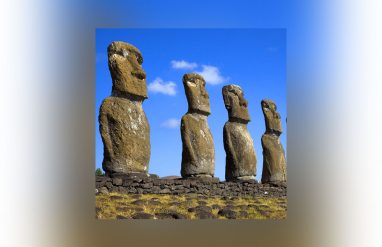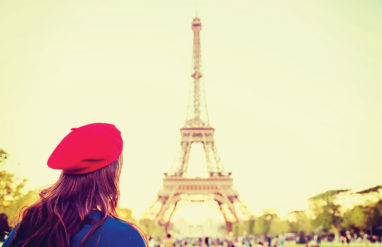Christmas is that special time of year that brings us joy—and at least a month and a half worth of hummable, merry carols to us all. Yes, Christmas is a magical time of good cheer, indeed! We’ve got mistletoe (for sneaking kisses), ugly-sweater competitions, and of course, the timeless traditions of decorating a tree, hanging up lights, and reminding kids to be nice so that Santa Claus will give them presents.
If you look into these traditions, you might be surprised to find out that many of them are a lot newer than you might expect. So join us, won’t you, as we gather round the fireplace, light up the yule log, and fill up a glass of eggnog while we share stories of where many of our favorite Christmas traditions originally came from.
🎄Take this quiz full of Christmas spirit
After you’ve learned about these Christmas traditions, return here to take our merry quiz to test your gift of traditions knowledge.
1. Red and green
When we think of Christmas, we often think of red and green decorations, red and green sweaters, or red and green poinsettias. According to most researchers, the association of the colors red and green with Christmas goes back quite a while and is often traced back to a certain plant: holly.
Holly plants are still common during Christmas today, and it is hard to miss their bright green leaves and red berries. Research suggests that Celtic peoples thought holly plants brought good luck, so they would decorate their homes with them during the winter. Holly is a winter blooming plant and may be one of the few signs of green during the season.
Most agree, however, that holly plants had a little help making red and green synonymous with Christmas. That help would come from a certain jolly gift giver and a major soda company. In the 1930s, Coca-Cola began a new advertising campaign in which Santa Claus—don’t worry, we're getting to him—was shown enjoying Coca-Cola products. This Santa, created just for the ads, wore a bright red suit and often posed in front of green backgrounds and Christmas trees. This specific image would become a cultural mainstay and help cement red and green into popular culture as the de facto colors of Christmas. [What Is “Mistletoe” And Why Do We Kiss Under It?]
2. Santa Claus
The big man himself tends to dominate Christmastime and for good reason; it’s hard to compete with a guy who gives free stuff to the entire world every year. Santa Claus is such a legendary figure that countless myths and traditions have emerged around him. After all, we’re all afraid to end up on his infamous Naughty List, and no self-respecting shopping mall would be caught dead without a yearly mall Santa. There’s even international tension between Canada and Finland over which country can rightly claim Santa as a citizen—yes, really.
But who is Santa Claus, and where did his story begin? The person behind the legends is actually a third-century Christian holy man now known as St. Nicholas. St. Nick was known for his kindness and generosity, and he loved to secretly give presents to children. He would become a local folk hero, and stories about him would expand into elaborate myths and legends over the centuries. With each new telling, different cultures and peoples would add their own spin and embellishments to the story of St. Nicholas. As time went on, these characters barely resembled the original St. Nicholas and became totally new figures separate from him. Today, the many countries of the world tell stories of many different versions of a St. Nicholas-inspired character that gives gifts to children during Christmas.
The Santa Claus that Americans know today is said to have emerged from the Dutch folktales of Sinterklaas, a character based on Dutch legends of St. Nicholas. As is American tradition, though, this character would become uniquely American over time as it would blend elements from different cultures and even mix in aspects of the British Father Christmas as well. The image of Santa we know today is often credited to cartoonist Thomas Nast’s depictions of him, which were featured in 19th-century magazines. Nast’s drawings of a fat, jolly old man in a red and white coat would inspire later depictions of Santa, such as the ones used in the popular Coca-Cola ads. [How To Help Your Kids Write A Letter To Santa]
3. Santa’s elves
As any Santa expert knows, Santa’s sack is full of toys made by elves who live with him in the North Pole. Elves can be traced back to ancient Germanic religions. According to legends, elves were small dwarf-like creatures with pointy ears who protected good people from evil. Like fairies, elves supposedly had magic powers and could often be mischievous tricksters. Santa Claus himself was even said to be an elf in the famous 1823 poem “A Visit from St. Nicholas,” also commonly known as “Twas the Night Before Christmas.” These elves are much shorter and less snooty than the tall and elegant elves you’ll often find in high fantasy stories.
But when did Christmas elves start working with Santa? The earliest popular association of Santa with elves may come from an 1857 story in Harper’s Weekly called “The Wonders of Santa Claus.” The story profiled Santa Claus and claimed that “he keeps a great many elves at work” making toys. This idea would stick around, and other artists (such as Norman Rockwell in 1922) would depict Santa employing a huge elf workforce as his toymakers. Elves then played a prominent role in the classic 1964 TV special “Rudolph the Red-Nosed Reindeer" (you'll meet him soon).
In 2005, the Elf on the Shelf joined Santa’s crew. Mother-daughter duo of Carol Aeborsold and Chanda Bell, introduced the little elf in their book The Elf on the Shelf: A Christmas Tradition. (We've got our own take on Elf on the Shelf games too!)
4. Santa’s reindeer
In order to deliver all those toys, Santa rides a magic sleigh pulled by nine—or eight, according to Christmas purists—flying reindeer. Any Santa fan can tell you that these reindeer are named Dasher, Dancer, Prancer, Vixen, Comet, Cupid, Donner, Blitzen, and Rudolph. But where did these reindeer come from? (Well, besides mommy and daddy reindeer, of course.)
Like much of Santa lore, the original eight reindeer are most often attributed to the same 1823 poem “A Visit from St. Nicholas” that said Santa was a fat, jolly elf. In the poem, Santa is said to ride a “miniature sleigh” pulled by “eight tiny reindeer.” The poem is also the source of the names of the original eight reindeer.
But do you recall the most famous reindeer of all? Rudolph and his famous nose wouldn’t play reindeer games until more than 100 years after the debut of the other eight reindeer. Rudolph was created by author Robert L. May, who wrote his story in a 1939 Christmas storybook used in a department store ad campaign. Millions of Rudolph books were sold, and the red-nosed Rudolph would become a Christmas staple thanks to the hugely popular song “Rudolph the Red-Nosed Reindeer,”(1939) written by songwriter Johnny Marks. [Words You Need To Know To Watch The Classic Holiday Movies]
5. Christmas stockings
Admittedly, this is one of the stranger Christmas traditions. Children are taught to hang stockings above the fireplace so that Santa will fill them with gifts during his holy-jolly form of home invasion. This tradition can once again be traced back to St. Nicholas.
According to a popular legend, a poor widower had three daughters who he lacked the means to provide dowries for. As the fate of marriage-less women at the time was not typically a happy one, St. Nicholas decided to help. One night, St. Nicholas discreetly hurled bags of gold into the family’s home. The story goes that the gifts landed in the young ladies’ stockings, which had been hung over the fireplace to dry after being washed. This story of good fortune spread and soon enough everybody was leaving socks above the fireplace in hopes that they too would get visits from a gold-flinging St. Nick. As St. Nicholas became associated with Christmas, this story and tradition came along for the sleigh ride.
6. Cookies for Santa
For all those presents he gives out, we all know that the only thing Santa wants in return is a plate of cookies and milk. Obviously, that belly like a bowl full of jelly had to come from somewhere, right?
In America, at least, this tradition can be traced back to the 1930s and was inspired by families' good intentions. It is said parents told their children to leave Santa a treat as a way to teach them charity and kindness during the rough times of the Great Depression. As many Santa traditions tend to do, the cookies stuck around even after the American economy improved.
Leaving Santa gifts isn’t purely an American tradition, though, as children in other countries also tend to leave Santa and/or his animals a midnight snack too. It is thought that all of these snacks for Santa can be traced way back to ancient Norse traditions. According to legends, the god Odin would ride his eight-legged horse Sleipnir across the land during winter. Rather than feed Odin, Norse children would leave out food for Sleipnir in hopes that Odin would give them presents to thank them on behalf of his eight-legged steed. (Fun fact: the name Odin is related to the word Wednesday.)
7. Presents
St. Nicholas was known to give gifts to children, which is why his Christmasy descendant Santa Claus does so as well. But why do the rest of us give each other gifts?
Gift-giving can be traced back very, very far in human history as evidence suggests that even prehistoric people exchanged gifts of food to each other. The ancient Romans attached a date to their gift giving, making a big show of giving each other gifts on Saturnalia. The biggest Roman festival of the year, Saturnalia occurred during the winter solstice. After Rome became Christianized, the pagan Saturnalia influenced other holiday celebrations, such as the celebration of the New Year and Christmas. For Christians, the Roman gift giving fit nicely with the story of the three magi giving gifts to Jesus Christ, and so gift giving became a tradition for Roman Christians during the winter holidays as well.
As for modern Christmas gift-giving, this tradition seems to have been strengthened and encouraged thanks to the popularity of Santa Claus and the commercialization of Christmas. After all, all those Christmas shoppers buying gifts every year are fantastic for business. (Kudos to those who dedicate their time and skills to handmade and homemade gifts.)
8. Christmas trees
Whether real or fake, a beautifully decorated Christmas tree can often be found inside a heavily decorated home just waiting for St. Nick to put wonderful presents (or a pair of socks) underneath it. Decorating buildings with trees during the winter is a practice that can be traced back to ancient peoples like the Romans and Egyptians, who often used trees to add to the beauty of shrines or temples.
However, the modern Christmas tree is said to come from German medieval traditions. Germans would decorate a tree in their homes on December 24 in order to celebrate the feast day of Adam and Eve. As time went on, these trees would also be used to celebrate the birth of Jesus Christ during Christmas. While it would remain popular in Germany, the Christmas tree wouldn’t spread to the rest of Europe until the 19th century, during the reign of Queen Victoria. Victoria, whose mother was German, and her German-born husband, Prince Albert, were fans of the tradition and kept a beautifully decorated Christmas tree in Windsor Castle. Victoria and Albert were very popular, and so Christmas trees flourished throughout Britain. Americans, who were apparently royal-obsessed even back then, saw Victoria’s tree in photos published in popular magazines and Christmas trees became all the rage in America, too.
9. Christmas decorations, ornaments, and lights
Decorating one’s home and hearth during the winter predates Christmas itself, as people belonging to ancient religions would fill their homes with holly and other natural items to celebrate a new year. In fact, the Christmas wreath may have been inspired by the laurel wreaths that the Romans used to celebrate Saturnalia. However, traditional Christmas ornaments and Christmas lights are actually more recent traditions, and both owe their popularity to the Christmas tree.
As mentioned earlier, Christmas trees were first popular in Germany. Germans would traditionally decorate their trees with naturally beautiful things like nuts, berries, and holly. In 1847, German glassworker Hans Greiner went the extra mile and made glass nuts and berries to decorate a Christmas tree. These ornaments, called baubles at the time, would later become spherical, and their popularity would result in a lot of money for Greiner’s family and business.
For Christmas lights, we need to go across the Atlantic and meet with an associate of Thomas Edison: a man named Edward Johnson. In the 1880s, Christmas trees had recently become popular in America. At the time, lit candles were a popular decoration for Christmas trees. In a very Edison-like fashion, Johnson saw a potentially lucrative opportunity. Thinking that American families would see value in not accidentally lighting their homes on fire, Johnson decorated a Christmas tree with a string of egg-shaped bulbs powered by electricity. Onlookers and the press were enamored with Johnson’s creation, but the wide adoption of Christmas lights wouldn’t occur until electricity became more affordable.
10. Advent calendars
For those who don’t know, Advent calendars are 24-day calendars with little doors or boxes that are opened each day to reveal a picture or a piece of candy. Modern Advent calendars usually mark each day from December 1 until December 24.
As you’d expect, Advent calendars were originally used to mark Advent, a period that begins four Sundays before Christmas which is dedicated to celebrating the birth of Jesus Christ. The creation of the printed Advent calendar is credited to Gerhard Lang. When he was a boy, Gerhard would receive a special calendar box from his mother that had 24 cookies sewn into the lid. Each day of Advent, little Gerhard would get to eat one cookie. As an adult, Gerhard made his own version of this box that had little doors with pictures behind them.
Advent calendars would jump from Germany to America thanks to President Dwight. D. Eisenhower. Eisenhower worked with German businessman Richard Sellmer to use Advent calendars to promote a charity. Eisenhower was photographed opening an Advent calendar with his grandchildren, and this holiday photo was published in major American newspapers. Advent calendars quickly became a hit with Americans and remain a holiday tradition today.
11. Nativity scenes
Among Christians, nativity scenes that depict the birth of Jesus Christ are a common sight during the Christmas season. The first nativity scene dates back all the way to 1223 and was the creation of St. Francis of Assisi. St. Francis encouraged all pilgrims to travel to Jesus’s birthplace of Bethlehem after his own journey there in 1221. However, the fighting of the Crusades made pilgrimages to Bethlehem dangerous, so St. Francis did the reasonable thing: bring Bethlehem to Italy.
St. Francis set up the original nativity scene in a cave in the Italian village of Greccio and included a live ox and donkey as part of the scene. St. Francis’s recreation of Jesus’s birth became very popular, and the idea spread throughout the Christian world. The idea was especially popular among the clergy because it allowed holy men to use visual images to teach the glory of Christ to a largely illiterate audience. Over time, the scenes would become more elaborate and add additional characters besides baby Jesus, Mary, and Joseph.
12. Christmas carols
Carols are actually older than Christmas itself as followers of ancient pagan religions would sing songs in celebration of the winter solstice. Christian priests loved these songs, but weren’t as in love with their secular approach.
Most sources agree that the first Christmas song ever sung was “Angel’s Hymn” in 129 CE. It was the result of the Bishop of Rome’s desire to shift the celebration of the winter solstice away from pagan rituals. While Christmas hymns were popular among the clergy, the Christian populace—who largely couldn’t understand the Latin lyrics—were less enamored by them. The wider acceptance of Christmas carols would result from the popularity of nativity scenes. When nativity scenes were performed, they were often accompanied by songs in the local languages. This meant that audiences could actually understand the words and join in on the singing.
As for door-to-door caroling, this is actually a more recent phenomenon. During the Victorian era, Christmas carols merged with an earlier English tradition known as wassailing, which involved visiting neighbors and wishing them good fortune. The merger of these two traditions gave rise to an era of Christmas carol-writing that is responsible for many of the popular Christmas carols still sung today. [Do You Know What These Words From Popular Christmas Carols Mean?]












